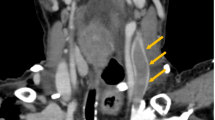Abstract
Background
We performed a retrospective observational study to examine the involvement of suspicious factors and causes of deep vein thrombosis using cases of esophagectomy that were done to treat esophageal carcinoma.
Methods
The 144 patients received esophagectomy in Okayama University Hospital from January 2005 to June 2007. All patients had an enhanced CT or an ultrasound examination after their operations. The incidence of deep vein thrombosis was then determined. For cases that found deep vein thrombosis, the anticoagulant treatment was strengthened. When the thrombosis was already so large to be seen in the inferior vena cava, the IVC filter was left to prevent a pulmonary embolism. Using JMP5.0.1 statistical analysis software, we analyzed the relationship between various clinical factors and the incidence of deep vein thrombosis.
Results
Using JMP5.0.1, factors causing deep vein thrombosis were analyzed and partitioning was done. The most significant risk factor causing deep vein thrombosis is leaving the central venous catheter inserted into the inguinal femoral area. Logistic analysis also showed that only the catheter if inserted from the inguinal femoral area, was significantly related to cause deep vein thrombosis (p < 0.0055). No other factor was a significant risk to cause deep vein thrombosis.
Conclusions
We analyzed the relationship between suspicious factors and the causes of deep vein thrombosis in cases of esophagectomy. The most relevant factors were inserting the central venous catheter from the inguinal femoral route. This evidence can be applied to both pre-operative and postoperative management to prevent deep vein thrombosis.

Similar content being viewed by others
References
Geerts WH, Bergqvist D, Pineo GF, Heit JA, Samama CM, Lassen MR, Colwell CW. Prevention of venous thromboembolism: American College of Chest Physicians Evidence-Based Clinical Practice Guidelines (8th Edition). Chest. 2008;133:381S–453S.
Lyman GH, Khorana AA, Falanga A, Clarke-Pearson D, Flowers C, Jahanzeb M, Kakkar A, Kuderer NM, Levine MN, Liebman H, Mendelson D, Raskob G, Somerfield MR, Thodiyil P, Trent D, Francis CW. American Society of Clinical Oncology guideline: recommendations for venous thromboembolism prophylaxis and treatment in patients with cancer. J Clin Oncol. 2007;25:5490–505.
Geerts WH, Pineo GF, Heit JA, Bergqvist D, Lassen MR, Colwell CW, Ray JG. Prevention of venous thromboembolism: the Seventh ACCP Conference on Antithrombotic and Thrombolytic Therapy. Chest. 2004;126:338S–400S.
Blom JW, Doggen CJ, Osanto S, Rosendaal FR. Malignancies, prothrombotic mutations, and the risk of venous thrombosis. JAMA. 2005;293:715–22.
Huber O, Bounameaux H, Borst F, Rohner A. Postoperative pulmonary embolism after hospital discharge. An underestimated risk. Arch Surg. 1992;127:310–3.
Levitan N, Dowlati A, Remick SC, Tahsildar HI, Sivinski LD, Beyth R, Rimm AA. Rates of initial and recurrent thromboembolic disease among patients with malignancy versus those without malignancy. Risk analysis using Medicare claims data. Medicine (Baltimore). 1999;78:285–91.
Sallah S, Wan JY, Nguyen NP. Venous thrombosis in patients with solid tumors: determination of frequency and characteristics. Thromb Haemost. 2002;87:575–9.
Thodiyil PA, Kakkar AK. Variation in relative risk of venous thromboembolism in different cancers. Thromb Haemost. 2002;87:1076–7.
Stein PD, Beemath A, Meyers FA, Skaf E, Olson RE. Deep venous thrombosis and pulmonary embolism in hospitalized patients with sickle cell disease. Am J Med. 2006;119:897e7–11.
Morris RJ, Woodcock JP. Evidence-based compression: prevention of stasis and deep vein thrombosis. Ann Surg. 2004;239:162–71.
Prevention of fatal postoperative pulmonary embolism by low doses of heparin. An international multicentre trial. Lancet. 1975;2:45–51.
Cham MD, Yankelevitz DF, Shaham D, Shah AA, Sherman L, Lewis A, Rademaker J, Pearson G, Choi J, Wolff W, Prabhu PM, Galanski M, Clark RA, Sostman HD, Henschke CI. Deep venous thrombosis: detection by using indirect CT venography. The Pulmonary Angiography-Indirect CT Venography Cooperative Group. Radiology. 2000;216:744–51.
Coche EE, Hamoir XL, Hammer FD, Hainaut P, Goffette PP. Using dual-detector helical CT angiography to detect deep venous thrombosis in patients with suspicion of pulmonary embolism: diagnostic value and additional findings. AJR Am J Roentgenol. 2001;176:1035–9.
Sakon M, Maehara Y, Yoshikawa H, Akaza H. Incidence of venous thromboembolism following major abdominal surgery: a multi-center, prospective epidemiological study in Japan. J Thromb Haemost. 2006;4:581–6.
Debourdeau P, Pavic M, Zammit C, Aletti M, Pogant C, Colle B. Post-treatment surveillance for potentially curable malignancies. Presse Med. 2007;36:949–63.
Beckers MM, Ruven HJ, Seldenrijk CA, Prins MH, Biesma DH. Risk of thrombosis and infections of central venous catheters and totally implanted access ports in patients treated for cancer. Thromb Res. 2010;125:318–21.
Lee AY, Levine MN, Butler G, Webb C, Costantini L, Gu C, Julian JA. Incidence, risk factors, and outcomes of catheter-related thrombosis in adult patients with cancer. J Clin Oncol. 2006;24:1404–8.
Akl EA, Karmath G, Yosuico V, Kim SY, Barba M, Sperati F, Cook D, Schunemann HJ. Anticoagulation for thrombosis prophylaxis in cancer patients with central venous catheters. Cochrane Database Syst Rev. 2007;2007:CD006468.
Sakon M, Kakkar AK, Ikeda M, Sekimoto M, Nakamori S, Yano M, Monden M. Current status of pulmonary embolism in general surgery in Japan. Surg Today. 2004;34:805–10.
Wagman LD, Baird MF, Bennett CL, Bockenstedt PL, Cataland SR, Fanikos J, Fogarty PF, Goldhaber SZ, Grover TS, Haire W, Hassoun H, Hutchinson S, Jahanzeb M, Lee J, Linenberger ML, Millenson MM, Ortel TL, Salem R, Smith JL, Streiff MB, Vedantham S. Venous thromboembolic disease. NCCN. Clinical practice guidelines in oncology. J Natl Compr Cancer Netw. 2008;6:716–53.
Joynt GM, Kew J, Gomersall CD, Leung VY, Liu EK. Deep venous thrombosis caused by femoral venous catheters in critically ill adult patients. Chest. 2000;117:178–83.
Merrer J, De Jonghe B, Golliot F, Lefrant JY, Raffy B, Barre E, Rigaud JP, Casciani D, Misset B, Bosquet C, Outin H, Brun-Buisson C, French Catheter Study Group in Intensive Care. Complications of femoral and subclavian venous catheterization in critically ill patients: a randomized controlled trial. JAMA. 2001;286:700–7.
Conflict of interest
None declared.
Author information
Authors and Affiliations
Corresponding author
Rights and permissions
About this article
Cite this article
Fujiwara, Y., Yamatsuji, T., Tanabe, S. et al. Utilization of partition analysis to evaluate the incidence on deep vein thrombosis following esophagectomy. Esophagus 10, 1–5 (2013). https://doi.org/10.1007/s10388-012-0350-8
Received:
Accepted:
Published:
Issue Date:
DOI: https://doi.org/10.1007/s10388-012-0350-8




